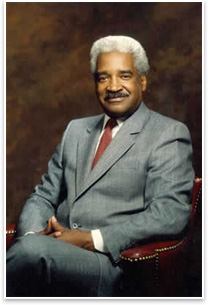Remembering a Gentle Giant, Wendell Campbell
 Summary: Wendell J. Campbell, FAIA, NOMA, one of the founders and the first president of the National Organization of Minority Architects (NOMA), died on July 9. He was 81. Starting his first architecture firm in 1966, Campbell worked continuously until his retirement in 2006. Summary: Wendell J. Campbell, FAIA, NOMA, one of the founders and the first president of the National Organization of Minority Architects (NOMA), died on July 9. He was 81. Starting his first architecture firm in 1966, Campbell worked continuously until his retirement in 2006.
“An inspirational and inspiring mentor to many African-American architects, including AIA President Marshall Purnell, FAIA, Campbell, along with several colleagues, founded NOMA in 1971,” said AIA Executive Vice President/CEO Christine McEntee. “Born into an environment of racial discrimination and hostility, he never allowed himself to be a victim, instead working tirelessly through his long life to break down the barriers that had prevented generations of talented young men and women from realizing their dreams in and enriching the profession.” President Purnell flew to Chicago to represent the AIA at the funeral July 16 that celebrated the healing legacy of an extraordinary man.
Advancing the profession of architecture
“The world—and specifically the world of architecture—has lost a leader with Wendell Campbell’s death,” wrote Curtis Moody, FAIA, president and CEO of the nation’s largest minority-owned and operated architecture firm, Moody Nolan Inc. “Yet, the legacy he leaves behind is one to be revered and celebrated. A renowned architect by trade, Wendell’s passion for building went well beyond the physical structures. He pioneered new and previously untraveled paths for minority architects, laying a solid foundation for my own success and that of so many others in the field. Wendell will be remembered most for the opportunities he helped create and make possible for minority practitioners—not just individually, but as a group—to advance the profession of architecture. And it is for this that I am most humbled, grateful, and proud of Wendell—my friend, colleague, and mentor. Wendell’s body has been laid to rest, but his legacy still lives in the hearts and buildings of those he continues to inspire. He truly is a history maker.”
"Wendell knew the pitfalls and things we would have to go through," Purnell’s partner at Devrouax & Purnell, Paul Devrouax, FAIA, told the Chicago Tribune about Campbell’s role as a mentor. "A lot of things Wendell had to say in our informal meetings were things he'd say he knew we would go through, and sure enough they did happen."
What he did with “The Dash”
The son of a carpenter, who was also the first black general contractor in Chicago, Campbell grew up in East Chicago where he later established his first firm, later expanding successive partnerships into Chicago and Gary. Active from his early days, in the NAACP youth group in the 1940s, Campbell was at the forefront of theater desegregation in East Chicago.
“What is important in one’s life is not the date of your birth or the date of your death, but “The Dash” that connects them, and what you did with “The Dash,” wrote Robert T. Coles, FAIA, in memoriam. “Wendell Jerome Campbell was the gentle giant who led the formation of what I feel is the most creative thing that African-American architects have done.
“I recall helping put together Wendell Campbell’s application for the 1976 Whitney Young Award as the AIA first Deputy Vice President of Minority Affairs in 1974-1976. [Purnell succeeded Coles in that position from 1976-1978.] In working with him on that document, I really got to know and love Wendell, the Gentle Giant, and his achievement in life and in architecture … Wendell J. Campbell—your dash was a wonderful and inspiring adventure. We will miss you.”
Campbell’s design work includes the Genesis Convention Center in Gary, Horace Mann High School, Ivy Tech Vocational School, fire stations, and community centers. His involvement in Chicago includes the McCormick Place Convention Center expansion, DuSable Museum of African-American History, Metcalf Federal Building, and Trinity Church.
The formation of NOMA
Coles also reminisced on how NOMA came to be: “I met Wendell in 1971 when we attended the AIA Convention in Detroit where, for the first time, a sizable number of African-American architects attended. At the AIA Convention in Portland in 1968 where Whitney Young spoke, only six African-American architects attended, but is was in Portland that the seeds of growth were planted for us, led by Robert Johnson Nash, FAIA. In Detroit, The African-American architects caucused in the office of black architect Nathaniel Johnson to discuss their unique concerns in practices that were primarily focused on housing and churches, as opposed to the corporate and private practices that their white counterparts had.
Several members of the group decided to meet in Nassau in the fall of 1971: “To analyze the contribution of practicing Black architects in America might make toward assisting to resolve problems which affect the economic, civic, and social environment.” As a result of the Nassau meeting, a group of African-American architects met in Chicago in March 1972 to form the National Organization of Black Architects, “whose name was later changed to the National Organization of Minority Architects to embrace all people of color in the profession,” Coles wrote. |


 Summary:
Summary: